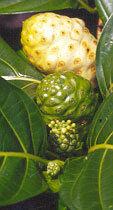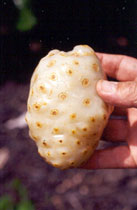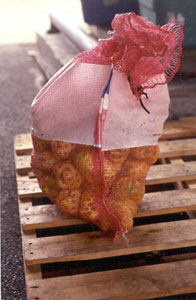| |
| When do young noni plants begin to bear fruit?
Noni plants can begin to bear fruit about 9 months to 1 year
after planting. Fruits can be harvested at this early stage,
although they are generally small and few. Some farmers choose
to forgo harvest during the first or second years in favor of
pruning back the branches instead. |

Under favorable growing conditions, noni plants may begin to
produce small flowers and fruits about 9 months to 1 year of
age. |
| When during
the year can noni fruits be harvested? In Hawaii, noni
fruits are harvested year round, although there are seasonal
trends in the amount of flowering and fruit production that
may be affected or modified by the weather and by fertilizer
and irrigation. Fruit production may diminish somewhat during
the winter months in Hawaii. A given noni field is usually harvested
from 2-3 times per month. |
| What are the
expected yields for noni plants? The following estimates
for the potential yield of noni plants are based on a series
of assumptions. Please be aware that many factors may diminish
yields. Nonetheless, the following estimates are achievable
with good farm management and excellent growing conditions. |
| Yield assumptions:
Plant population: 290 plants per acre; good soil fertility and
drainage; good water supply; adequate disease, pest and weed
control; adequate fertilizer plan (e.g., 6 lbs of 10-20-20 per
plant per year). |
| Month |
Expected Fruit
Yield* |
| 0-9 |
Seedlings grown in nursery, no fruit production |
| 9 |
Transplant into field, no fruit production |
| 12-24 (year 1) |
2 lbs fruit per plant per month (i.e., 24 lbs per plant
per year 1) |
| 24-36 (year 2) |
4 lbs fruit per plant per month (i.e., 48 lbs per plant
per year 2) |
| 36-48 (year 3) |
8 lbs fruit per plant per month (i.e., 96 lbs per plant
per year 3) |
48-60 (year 4)
|
15 lbs fruit per plant per month (i.e., 180 lbs per
plant per year 4) |
| 60-72 (year 5) |
20 lbs fruit per plant per month (i.e., 240 lbs per
plant per year 5) |
|
*Realistic estimates
based on excellent farm management practices and growing conditions.
Actual yields may vary.
Therefore, based on this model, at year 5 a farmer can expect
to harvest approximately 69,600 lbs of fruit per year per acre,
yielding about 35,000 lbs of juice (at an extraction efficiency
of approximately 50% by weight). The juice weighs about 9 pounds
per gallon, so an acre of well-managed noni can produce approximately
3,800 gallons of juice per year.
For mature trees or farms older than 5 years, yields of up to
500 lbs of noni fruit per plant per year may be realized. However,
many factors can impinge on these numbers. Most farmers do not
realize the attainable yields due to pest and diseases or poor
agronomic practices. On average, one might expect the average
farmer to realize yields significantly less than 50,000 pounds
of fruit per acre per year. |
|
| At what stage
of development are noni fruits picked? Noni fruits
can be picked at any stage of development, depending on the
intended processing method. Some producers prefer green fruits,
whereas other processors prefer the hard white noni fruits for
processing. Most noni juice processors accept or prefer the
“hard white” stage of fruit development for noni
juice production, because the fruits ripen quickly once that
stage of development is reached. |

Noni fruits in various stages of development, from flowering
(foreground) to “hard white” (background). Noni
fruits may be picked at any stage of development, depending
on the intended product or processing operation. The “hard
white” fruits are usually picked for processing of the
traditional noni juice beverages. |

Translucent noni fruit, 1-2 days after harvest of the “hard
white” stage. The translucent fruits are ready to release
their juice. |
| How are noni
fruits harvested and handled? Noni fruits are harvested
by hand by picking the individual fruits from the branches.
They are placed in baskets or bags or placed in bins for transport
to the processing facility. Noni fruits do not bruise or damage
easily, and usually no special padded containers or other precautions
are needed to prevent fruit significant fruit damage. Furthermore,
exposure of noni fruits to direct sunlight or to warm temperatures
immediately after harvest is not a significant concern. So,
noni fruits need not be refrigerated after harvest and are usually
not refrigerated. |
| How are noni
fruits handled at the processing facility? Fruits are
washed at the processing facility before they ripen fully and
turn soft. For juice production, the noni fruits are held at
ambient or room temperature for 1 to several days to ripen before
they are processed. However, prompt processing for juice is
important, for if ripe fruits are allowed to sit for an extended
period, they begin attract unwanted fruit flies, rats and other
insects or pests. For processing of noni fruits for powders
or other precuts, the fruits may be processed immediately, before
they fully ripen. Unripe fruits are easier to work with some
types of chopping and drying equipment. |

Hard white noni fruits arrive at a processing facility in an
onion bag. |
| Back to Top |

